Posted on 11/1/2008
Source: Digital Engineering
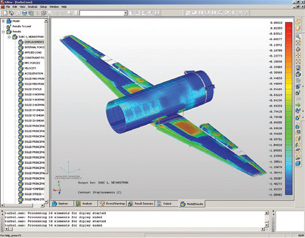
This is an NEi Nastran Tension-Only Quad Element analysis specifically created to model highly nonlinear behavior of load transfers in wing and fuselage structures. (Image courtesy NEi Software)
How often do you need to tackle shot peening of a turbine blade? Evaluate the safety of a proposed mining excavation? Minimize vibro-acoustic problems in automotive design? If your company focuses on a vertical industry, the answer could be “every day.” For many such challenges, you’ll get the fastest results using software streamlined for your day-in, day-out applications.
Engineers who simulate load stresses on multi-ply tires today will probably not be designing washing-machine gears tomorrow, so specialized software can provide a real boost in efficiency. General solvers certainly have their place, but niche software can work side-by-side with those packages, saving time by offering menus with just the right language and options; no more, no less. This article examines a number of such analysis products as well as some sample “niche” applications that may surprise you with their pervasiveness.
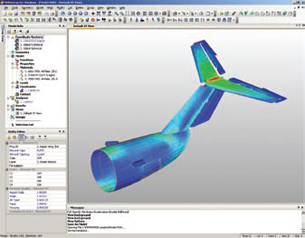 The NEi Tension-Only analysis is used by Cessna. (Image courtesy of NEi Software) |
Focus on Mechanical Stress
Mechanical analysis is the foundation of many engineering design projects. No wonder so many packages have been developed that help users build specific model types and subject them to very specific loads. Sometimes the niche solution is driven by one customer’s needs, which opens up a new problem-solving method for other users.
A chance meeting between engineers at NEi Software and Cessna Aircraft led to the design of a Tension-Only Quad (TOQ) element for modeling the detailed behavior of wing and fuselage structures. In real components, certain areas undergo compression that creates buckling. In the virtual world, there had been no good way to model this highly nonlinear action where the resulting semi-diagonal tension field transfers the load to other structural members.
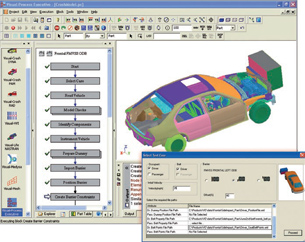 |
NEi Software solved the modeling problem by incorporating a unique effectiveness factor, allowing the panels to carry both a tension and compression capability as needed. The Cessna engineers found that using this modeling element within an NEi Nastran analysis allowed them to combine six different tail-section models (originally for each of six load orientations) into one. This difference saved a great deal of overhead any time the geometry was changed, eliminating repetitive work functions and reducing the analysis cycle time.
In the case of automotive design, design factors can stem not just from consumer input but from government regulations. ESI Group tackles these requirements with PAM-CRASH 2G, its second-generation analysis package for crash simulations.
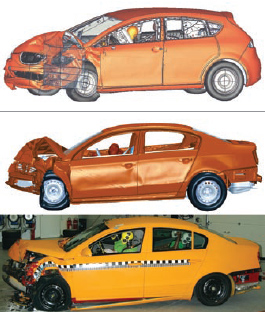 A5 Frontal impact of a VW Passat according to Euro-NCAP Simulation and Test, as calculated with PAM-CRASH 2G from ESI Group. The photo shows a comparison to physical crash test results. The PAM-CRASH 2G workflow helps users build their models faster while verifying designs against government regulation compliance. (Image courtesy of Volkswagen AG) |
Because the federal government defines the pass/fail criteria for automotive crash-worthiness, the end user has limited leeway in design. The actual analysis is based on classic finite element analysis (FEA) of door-facings, padding, seat design, and airbags, but the graphical user interface (GUI) is tailored to the end-application. PAM-CRASH 2G offers a workflow that helps users build their models faster while combining regulatory compliance, standard operating procedures, and best practices.
Designers can quickly set up a scenario where they set the vehicle speed, choose a crash barrier of a certain shape and material, and select one of a number of defined crash-dummies with its own set of parameters. Postprocessing capabilities make it easy to look at the resulting head and neck acceleration that the dummy model experienced. PAM-CRASH 2G simulations even allow for variations in manufacturing tolerances from different casting and forming processes. The results help designers evaluate how such variables as plastic deformation or the thickness distribution on a door panel impacts crash worthiness.
Solving for Mine Safety
Recent tragedies in the realm of mining safety have highlighted the need for improved planning and operations. Abaqus FEA software from SIMULIA, the Dassault Systèmes brand for realistic simulation, is now used to analyze models of mines around the world. The goal is to successfully engineer the safety and productivity of planned deep-mining operations.
Using measurements of site deformation and seismic activity, Abaqus FEA models have been calibrated, and in a single day, used to simulate a full, 3D inelastic model of a mine’s lifecycle. These models are able to include rock mass volumes spanning several kilometers around an ore body. To understand the effect of seismic events, SIMULIA engineers have developed a targeted Dissipated Plastic Energy (DPE) analysis method. Abaqus can also evaluate the unusual strains and loads involved in mine excavation in order to design appropriate ground supports. Users compare the cost savings and improved safety achievements to those gained through “what-if” crash simulations in the automotive world.
Composite Modeling
Use of composite materials, still not as well understood as traditional materials, brings both benefits and challenges to the engineering world. The properties of these customized materials can display strengths comparable to those of metals yet at a dramatically lower weight, making them increasingly attractive to engineers crafting fuel-efficient vehicles in the automotive and aerospace industries. However, understanding these materials presents complex issues as designers must predict manufacturability as well as short- and long-term behavior.
Since 1995, Collier Research has been developing NASA technology into the HyperSizer family of software targeted specifically to structural composite analysis. Material Manager helps users design laminates made with metals, foams, honeycomb cores, ply tapes, and fabrics. Users can calculate stiffness, thermal coefficients, and equivalent properties. HyperSizer Basic includes these material functions, but adds stress analysis and detailed design sizing to optimize weight while achieving structural integrity for all combinations of loads. HyperSizer Pro offers the capabilities of Basic along with coupling to third-party FEA software for advanced analysis, including updating the FEM. The software’s newest release automatically generates stress reports.
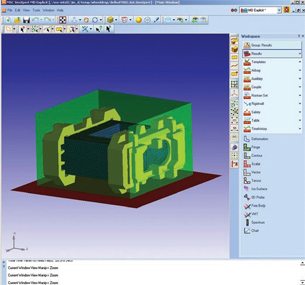 |
MSC.Software has long been known for its family of products that handle multidisciplinary problems. One of these offerings is Dytran, an FEA solution for analyzing complex nonlinear behavior involving permanent deformation, often difficult or financially impossible to test. Translation: this software helps you simulate the behavior of small to extremely large assemblies in disastrous events, ranging from dropping a cell-phone to the impact of a ship running aground. It combines structural, material flow, and fluid-structural interaction (FSI) analysis in a single package.
The most recent release of Dytran is completely integrated into MSC.Software MD Solutions, gaining the modern GUI and pre- and postprocessing capabilities found throughout the MSC SimXpert environment. This coupling also means that users can take advantage both of Dytran’s traditionally explicit FSI solutions (for extremely transient events such as airbag inflation) and the implicit solver approach found in MD Nastran (especially useful for events such as sheet-metal forming).
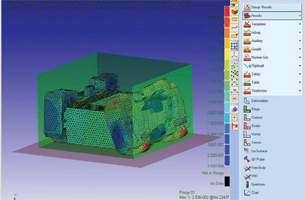 Drop test simulation of a computer using MSC.Software SimXpert Explicit. T he model is being evaluated to see how well the foam packaging around the computer absorbs the shock of the drop. (Images courtesy of MSC.Software) |
Rotorcraft Design
For engineers working on rotorcraft, gas turbines, or any systems with rotating blades, understanding the dynamic influence of resonant and forced vibrations is a critical yet potentially complex process. NISA/ROTOR is a software module from Cranes Software developed exclusively for simplifying the task of analyzing rotor bearing systems coupled to foundations, and understanding their behavior in both transient and steady-state operating conditions.
NISA/ROTOR, as part of the suite of NISA FEM products, helps engineers readily investigate the unique behavior of these rotating systems. The preprocessor lets users input bearing coefficients such as stiffness and damping, or compute the dynamic coefficients from characteristic parameters. The FE library contains the necessary elements to model a rotating shaft, disks, flywheels, bearings, foundations, and pedestals. Special solvers perform analyses in both the time and frequency domains, including those based on unsymmetrical matrices, and the postprocessor presents exact application-specific data such as critical operating speeds by way of Campbell diagrams, whirl orbits, and mode shapes showing unbalanced responses.
Piping Behavior
Another field where government regulations rule is in piping systems, whether for processing chemicals, cooling a nuclear-power plant, or pumping offshore oil. ALGOR’s PipePak package provides piping system designers with a tool for efficiently creating complete systems and performing relevant structural analyses. Typical simulations include verifying performance under thermal loads and seismic vibrations.
| Weighing the Options: Broad or Niche? There are many CAE options available today ranging from highly specialized software that offers ease of use for a specific class of problem to generalized codes that solve a broad spectrum of problems.Specialized programs are appropriate for companies that regularly need solutions for one ongoing type of application or solutions specific to one field. Such programs allow users to easily build and solve models using the parameters and language specific to that field. The typical user might need little or no training to become and stay proficient with the software, and the packages are usually cheaper than the generalized ones. General-purpose programs solve problems from many disciplines across many industries, including the problems solved by the specialized codes. Some of these programs do so by offering plug-in, targeted modules, effectively making them specialized. A company owning generalized software has the flexibility to develop its CAE capabilities as it expands into new market areas. Some general codes even couple physical effects across multiple disciplines, greatly broadening their usage and allowing deeper understanding of the underlying physics. So, specialized programs offer lower purchase price, ease of use, and a lower cost to establish and maintain trained personnel. However, generalized programs are powerful, can solve many types of problems, and allow future expansion. If you’re not sure what path will best suit your needs, ask for advice from an analyst experienced in the codes you are considering. — Roxanne Abul-Haj, Principal Engineer, ARA Engineering |
Although such work could be done with a general FEA program, it could take hours of modeling and analysis to look at a design of just several dozen pipes. PipePak is structured to let engineers easily lay thousands of pipes point-to-point and add hundreds of fittings from a large library of standard parts. The software can import specifications from spreadsheet data and DXF files, still a common approach for this industry, or from models created in ALGOR’s FEMPRO package. It also supports industry-standard piping codes that let users evaluate proposed designs against safety code specifications.
What users consistently say about targeted software is that having menus, libraries, parameters, and input/output formats specific to their needs is an enormous time-saver. If your designs revolve around the products and services needed by a certain industry, or you always tackle a specific mechanical task, it could make real financial sense for you to check out what these niche analysis packages can offer.
